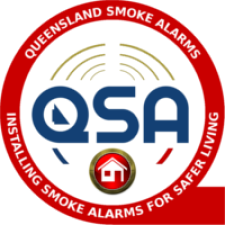WHAT ARE THE NEW QUEENSLAND SMOKE ALARM LAWS?
From 1 January 2017 when replacing smoke alarms, they must be of a photoelectric type which complies with Australia Standard (AS) 3786-2014.
Existing smoke alarms, manufactured more than 10 years ago, must be replaced (Note: smoke alarms should have the date of manufacture stamped on them).
Smoke alarms that do not operate when tested must be replaced immediately.
Existing hardwired smoke alarms, that need replacing, must be replaced with a hardwired photoelectric smoke alarm.
What are the main differences with Red Professional $143.00 and Red Original $121.00
The Red Professional range is made of High-Grade ABS Plastic, slimline, more modern looking, smaller in diameter and has a lower profile than the original range. It also has a dual mesh barrier system reducing false alarms, keeping out more dust, bugs, insects, and moisture which can cause false alarming
WHO AND WHAT TYPE OF DWELLING IS AFFECTED BY THE NEW QUEENSLAND SMOKE ALARM REGULATIONS?
All Queensland home-owners must abide by this new smoke alarm regulation by a set date 1.1.22 for landlords and 1.1.27 for owner occupiers.
The new legislation only affects class 1a buildings (eg. Houses/townhouses) and class 2 buildings (eg units/apartments). It does not include short term stay dwellings such as motels, dormitories, caravans or other buildings. These other buildings are covered by the requirements of the National Construction Code (NCC).
WHEN ARE THE NEW QUEENSLAND SMOKE ALARM LAWS EFFECTIVE FOR LANDLORDS?
From 1 January 2022 Queensland landlords must have photoelectric, hardwired or powered by a non-removable 10-year battery smoke alarm installed in each bedroom; and in hallways which connect bedrooms and the rest of the dwelling; or if there is no hallway, between the bedrooms and other parts of the storey; and if there are no bedrooms on a storey, at least one smoke alarm must be installed in the most likely path of travel to exit the dwelling.
WHAT IS A SMOKE DETECTOR?
A smoke detector is an electronic fire-protection device that automatically senses the presence of smoke, as a key indication of fire, and sounds a warning to building occupants. Commercial and industrial smoke detectors issue a signal to a fire alarm control panel as part of a building’s central fire alarm system.
WHAT IS A SMOKE ALARM?
Smoke alarms are self-contained smoke-sensing devices that issue an audible or visual alarm from the device itself or several detectors if there are multiple smoke detectors interlinked.
HOW DO SMOKE ALARMS WORK?
Photoelectric smoke alarms, also known as optical or photo-optical, detect visible particles of combustion. Research indicates that these types of smoke alarms are generally more effective across a wider range of fires experienced in homes. They respond quicker to smouldering fires and the dense smoke given off by foam filled furnishings or overheated PVC wiring. In 2017 the Queensland Government staggered an introduction of new laws whereby all smoke alarms in Class 1A and 2 dwellings must be photoelectric and interconnected by 1.1.27.
SHOULD I GET CLIPSAL SMOKE ALARMS INSTALLED?
Clipsal by Schneider Electric was established in 1920 and is Australia’s number one electrical brand of electrical products, accessories and solutions for the residential, commercial and industrial markets. They come with a 5-year warranty. Not the best for wireless applications but great value for mains power 240v.
SHOULD I GET BROOKS SMOKE ALARMS INSTALLED?
Brooks are undoubtedly the best smoke alarms on the Australian smoke alarm market, but you will pay for what you get. They have the least fault rate which is worth it given that Queensland dwellings will have a lot more interconnected smoke alarms in their home after the new laws were introduced. Just remember if 1 smoke alarm faults then they are all triggered. Brooks is a 100% Australian owned company and are specialists. They come with a 5 year warranty but are likely to last for 10 years without issues.
SHOULD I GET RED SMOKE ALARMS INSTALLED?
RED is a new smoke alarm on the Australian market. They offer a 10-year warranty and with their history to date we believe that they are the most affordable wireless smoke alarm option. Their manufacturing facility has been manufacturing smoke alarms for the Australian market for more than 20 years and is certified by UL Laboratories – one of the world’s largest testing and certifying companies.
WHEN DO LANDORDS HAVE TO COMPLY WITH NEW QUEENSLAND SMOKE ALARM LAWS?
Landlords must upgrade the smoke alarms in accordance with the new Queensland smoke alarm regulations in their leased properties by 1.1.22.
WHEN DO OWNER OCCUPIERS HAVE TO COMPLY WITH THE NEW QUEENSLAND SMOKE ALARM LAWS?
If you are an owner occupier you have until 1 January, 2027 to comply with the new Queensland smoke alarm regulations.
I AM A LANDLORD, WHAT ARE MY OBLIGATIONS WITH SMOKE ALARMS?
Landlords must have the smoke alarms in their rental properties tested and cleaned and replace any flat batteries within 30 days before the start of a tenancy. They must not remove a smoke alarm or a batter (other than to replace it), or do anything to reduce the effectiveness of the alarm e.g. paint it.
SMOKE ALARM MAINTENANCE SOLUTIONS?
You do not need to be qualified or licensed to clean or test a domestic smoke alarm. Some real estate agents may outsource smoke alarm maintenance to another company such as Queensland Smoke Alarms as part of their processes. Tenancy rules permit entry for the purposes of complying with smoke alarm legislation.
SMOKE ALARM INSTALLERS IN BRISBANE
Carefully choose your smoke alarm installer and be sure to check their electrical licence and the terms and conditions of warranty, that’s if they offer a warranty for their installation and the product they install.
SMOKE ALARM WARRANTY
Smoke alarm manufacturers will generally only warrant their product if it has been installed, operated and maintained in accordance with their manual or operating instructions provided with the product. Always keep your receipt as proof of purchase. Most warranty applications are requested online, however if you choose an installer who can is a warranty agent then the process is made much simpler and quicker.
PHOTOELECTRIC SMOKE ALARMS VS IONISATION SMOKE ALARMS
These smoke alarms sense the presence of smoke differently. Ionization smoke alarms tend to respond faster to the smoke produced by flaming fires than photoelectric smoke alarms. Photoelectric smoke alarms tend to respond faster to the smoke produced by smouldering fires than ionization smoke alarms.
HOW MUCH DOES IT COST TO INSTALL AN INTERCONNECTED, PHOTOELECTRIC SMOKE ALARM?
Depending on the brand you choose, expect to pay between $140.00 and $220 for an electrician to supply and install a photoelectric, interconnected smoke alarm.
WHAT ARE THE PRESCRIBED LOCATIONS FOR INSTALLING SMOKE ALARMS?
While the centre of the room is the preferred location for smoke alarms, this is not a requirement. On the ceiling they must be 300mm from covers or lights and 400mm from anything that may blow air such as an air conditioner or the edge of the blade of a ceiling fan. They must also be at least 300mm from a corner of a ceiling and a wall. There are special requirements for sloping ceiling and ceiling with exposed beams.
WHAT DOES INTERCONNECTED MEAN?
This means that if one smoke alarm detects smoke, they all sound. Interconnected smoke alarms are connected to other smoke alarms in the dwelling either directly or wirelessly.
WILL I HAVE TO RUN NEW WIRING IN MY HOME TO INTERCONNECT THE SMOKE ALARMS?
Smoke alarms can be interconnected any way that allows all smoke alarms to sound when one is in alarms (i.e. when one activates they all sound). This can be done by physically wiring together or using wireless technology (or a combination of both). Wireless technology is available for both 240-volt (mains powered) and battery- operated smoke alarms.
HOW TO INSTALL INTERCONNECTED, PHOTOELECTRIC SMOKE ALARMS
Existing hardwired smoke alarms must be replaced with a hardwired smoke alarm. This smoke alarm installation type is connected to the electricity supply and must be connected by a licenced electrician. If your dwelling was built before 1997 it’s likely you won’t have a hardwired smoke alarm. If this is the case then you can upgrade your entire dwelling using wireless smoke alarms with a 10 year non-removable battery.
HOW OFTEN SHOULD SMOKE ALARMS BE TESTED IN AUSTRALIA?
Smoke alarms should be tested once a month using the test button. All Australian Standard smoke alarms have a test button on their exterior. If you cannot reach the button easily, use a broom handle. Some smoke alarm brands offer a wall mounted control switch where you can test, locate and silence your smoke alarms.
HOW OFTEN SHOULD SMOKE ALARMS BE MAINTAINED?
Smoke alarms should be maintained once a month to check the operation of the smoke alarm. Maintenance includes testing the smoke alarm by pressing the test button. Cleaning the smoke alarm with a duster or vacuum cleaner. Dust, debris and bugs can interfere with their operation. Replacing removable batteries, if applicable, annually. If you are a landlord and lease a dwelling in Queensland then you have an obligation to carry out this maintenance within 30 days of a new or renewal of a tenancy.
HOW OFTEN SHOULD SMOKE ALARM BATTERIES BE REPLACED?
Removable smoke alarm batteries should be replaced every 12 months. If the smoke alarm makes a ‘chirping’ sound then this may indicate a flat battery. An instrument called a multimeter can be used to test the voltage in a battery. If you are unable to measure the voltage in a battery then replace it. Smoke alarms can have rechargeable batteries in them. Rechargeable batteries are recharged by mains power (240v) therefore they do not require replacing. Wireless smoke alarms have a non-removable 10-year lithium battery in them therefore they also do not require replacing.
HOW ARE SMOKE ALARMS WIRED?
Hardwired smoke alarms must be installed by a licenced electrician. All 220-240v wiring must comply with AS/NZ3000 wiring rules.

